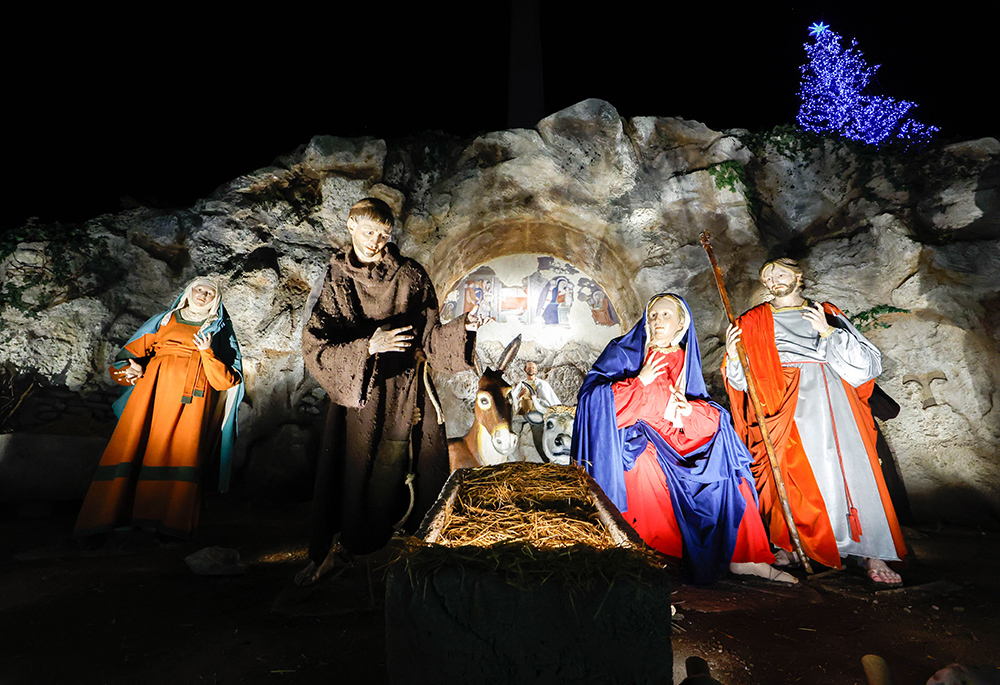
The Nativity scene is revealed and the Christmas tree is lit in St. Peter’s Square Dec. 9 at the Vatican. The crèche is a reproduction of the scene in Greccio, Italy, where St. Francis of Assisi staged the first Nativity scene in 1223. The baby Jesus will be placed in the manger Dec. 24. (CNS/Lola Gomez)
This year marks the 800th anniversary of the hallowed Christmas Eve in 1223 when St. Francis of Assisi summoned the people of Greccio, Italy, to a manger he had arranged with straw and a breathing ox and ass. The atmosphere he evoked as he sang the words of the Gospel telling of the Virgin Mary and St. Joseph traveling to Bethlehem where the Savior came to Earth, filled his hearers with joy. Feeling as if they were present at the sacred event, they were renewed.
For this reason, St. Francis has long been widely, but inaccurately, hailed as the inventor of the Christmas crèche, the beloved collection of figurines set up in churches, homes and, sometimes controversially, in public places. But a crèche is not what St. Francis created.
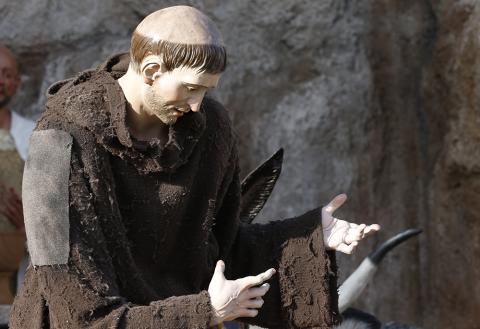
St. Francis of Assisi is depicted in a Nativity scene in St. Peter's Square Dec. 14 at the Vatican. (CNS/Justin McLellan)
The true Christmas crèche, from the French word for crib, is a grouping of three-dimensional sculptured figures tiny or large, that includes the Blessed Mother and St. Joseph by the baby Jesus lying a manger. An ox and ass are with them, all under a prominent star. Nearby are shepherds as well as the Magi.
So if St. Francis did not invent the crèche with these specific figures, who did? The Jesuits — at least, according to the best written evidence. A history of the Society of Jesus says they set up the first one in Prague as early as 1562, almost 350 years after St. Francis' wondrous evening at Greccio. The scholar Rudolf Berliner cites that book in his 1946 article "The Origins of the Crèche" and reports that within a few decades, other orders — including the Carmelites, the Augustinians and yes, the Franciscans — were following the Jesuits' lead.
Fr. Tom Worcester, a Jesuit and history professor at Fordham University, points out that this was the period of the Protestant Reformation, saying, "I think what helped to bring it about was that the Protestants rejected celibacy and their clergy married. There was emphasis on the goodness of marriage. Part of the Catholic response was to say, 'We too are in favor of the family. The Holy Family is our model, Mary, Jesus and Joseph.' Well, it had not been before. In the Middle Ages the images were Madonna and Child, with Joseph rarely shown."
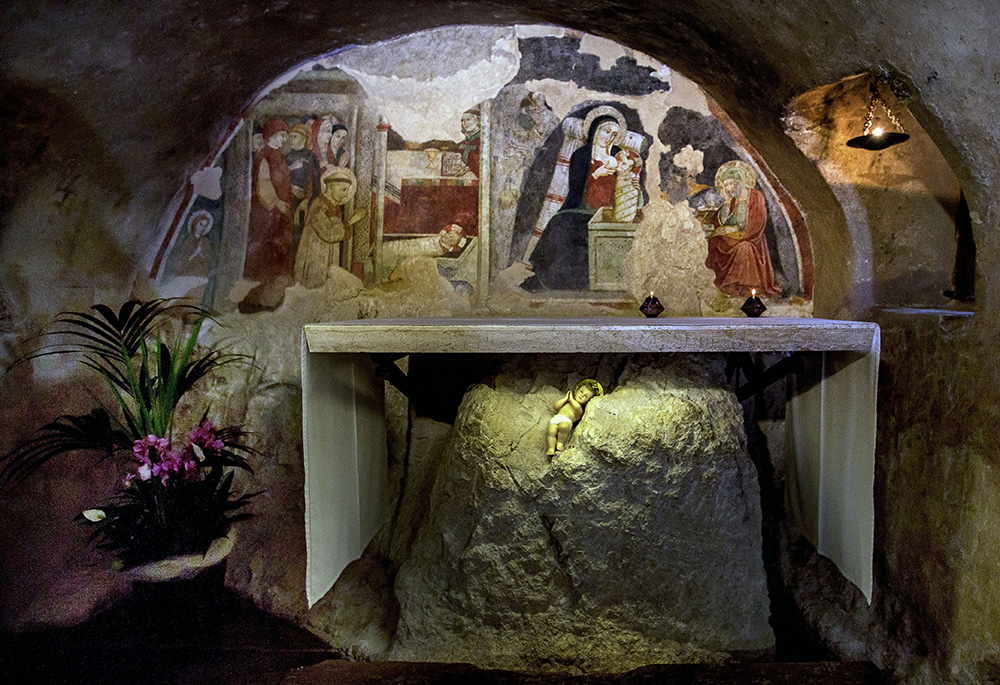
This 2013 file photo shows the fresco of St. Francis of Assisi adoring the baby Jesus in the Chapel of the Nativity in Greccio, Italy. The chapel is built in the grotto that tradition says is where St. Francis arranged the first Nativity scene in 1223. (CNS/Octavio Duran)
St. Francis' evocative, emotion-charged dramatic tableau lacked human figures. His iconic achievement belongs in the realm of sacred drama and is more in keeping with the tradition of liturgical plays, as scholars pointed out early in the 20th century.
It's possible that he became associated with the treasured tiny scenes under so many Christmas trees because of a loose use of definitions. The word "manger," which in French means "to eat," originally referred to a stand for animal feed, but came to denote the entire depiction of the birth of Christ, as did the term "Nativity scene," which might as easily also describe a painting or a fresco. The late Latin word cripia, for the stand for animal feed, evolved in French into crèche, meaning crib, that took on a connection to the whole stable or grotto of Christmastime.
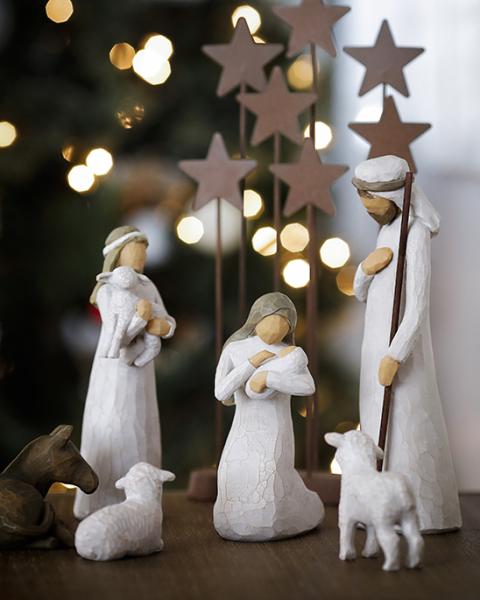
The birth of Christ has been depicted in Nativity scenes for nearly 800 years. These figurines were designed by U.S. artist Susan Lordi of Willow Tree sculptures. (CNS/Nancy Wiechec)
And while the elements of the Nativity scene may seem obvious today, they did not come together until some 500 years after the birth of Christ. Of the four books of the Gospels, only Luke presents the infant lying in the manger surrounded by Mary, Joseph and the shepherds. Matthew mentions only the virgin birth before turning to the travels of the Magi, bearing gifts of gold, frankincense and myrrh following the guiding star.
The earliest known pictorial references to the birth of Christ are in the city of Rome. The first is in the third century catacombs of Priscilla and depicts only a seated woman presumed to be Mary holding her baby as the Magi approach with gifts. A century later, on a marble sarcophagus at the cemetery of St. Agnes, the Magi's camels are shown with them and the Holy Family. Once Dec. 25 was fixed as the date for the celebration of Jesus' birth in the fourth century, Luke's depiction of the scene in Bethlehem began to be depicted in sculpture of three dimensions.
According to Berliner, in 1619, nearly 60 years after the first reported crèche in Prague, Fr. Philippe de Berlaymont wrote that his fellow Jesuits continued to follow the custom of their predecessors and were setting up crèches with the intention of bringing to life the Nativity. In his book published in Cologne, with detail that would have pleased St. Ignatius of Loyola, he listed the elements of their crèches. These are the ones we expect today — the infant lies in a manger between Mary and Joseph in a structure with a straw roof topped by a star.
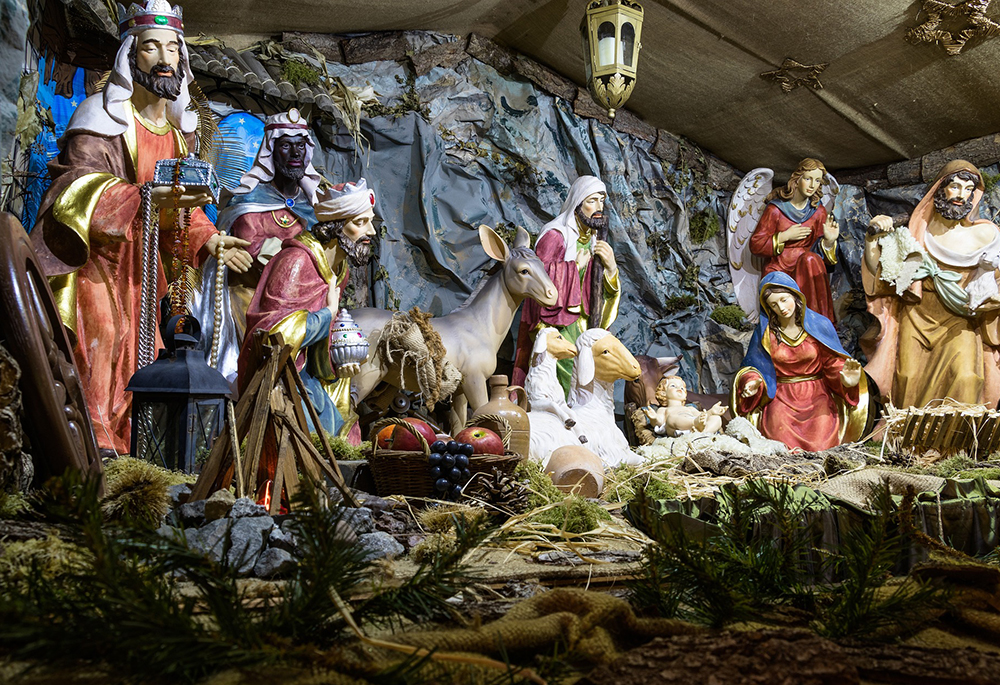
(Pixabay/Herbert Aust)
Fr. Dominic V. Monti, a Franciscan friar and a Distinguished Professor of Franciscan Studies at St. Bonaventure University, says, "Deciding who invented it is almost futile. It depends on how you define it. You can say it has to include certain things and then put them there. Is the question about very specific elements that have to be there or is it about a fascination with the human reality of Christ's birth?" He further notes, "Francis was not into figurines!"
De Berlaymont's Latin text as Berliner translated it reads in part:
Shepherds and angels are in attendance, the whole being so cleverly arranged that the devotion of the beholders is vigorously stimulated. They feel themselves to be participating in this so miraculous event, hearing with their own ears the crying of the Child and the heavenly music, touching with their own hands the swaddling clothes, and experiencing a pious awe.
Advertisement
That of course is what St. Francis achieved at Greccio. Steven F. Ostrow, a professor of art history at the University of Minnesota and the author of Art and Spirituality in Counter Reformation Rome: The Sistine and Pauline Chapels in S. Maria Maggiore, says, "Yes, the Jesuits were much better record keepers than the Franciscans, obsessively so. I have no doubt they were the first to create a crèche that was documented in that way. But my perspective is that although what Francis did in Greccio was in the tradition of liturgical drama, it doesn't negate its original nature as the ultimate source for what the Jesuits did later. It was the Franciscan mode of spirituality that underlies the tradition of the crèche — a spirituality rooted in a deep-seated faith in the humanity of Christ and on his humility and poverty. And this is closely connected to the Franciscan devotion to Mary as a mother as opposed to the queen of heaven."
De Berlaymont went further than making a list of essential elements. He speculated that the scene of the sacred birth in Bethlehem was inspired by images of the Egyptian goddess Isis holding the infant Horus. Fr. Théophile Raynaud, another Jesuit, disagreed. He suggested that the idea for the crèche might have sprung from the example that St. Francis set at Greccio. Thus, quite possibly, in addition to inventing the crèche, the Jesuits created the false impression that Francis of Assisi had originated it.




